 The VW plant in Emden is a well run plant, and among the best in the Volkswagen group. It is also producing only fully electric battery powered vehicles… which are not selling well. This leads to a lot of struggles and problems for the plant. Producing only one type of power train makes production more efficient but less flexible. And Emden is paying the price for this lack of flexibility. Other car makers usually opt to produce all kinds of power trains on the same assembly line. But the organization and lean-ness of the plant was good compared to other German car plants. Let’s have a look.
The VW plant in Emden is a well run plant, and among the best in the Volkswagen group. It is also producing only fully electric battery powered vehicles… which are not selling well. This leads to a lot of struggles and problems for the plant. Producing only one type of power train makes production more efficient but less flexible. And Emden is paying the price for this lack of flexibility. Other car makers usually opt to produce all kinds of power trains on the same assembly line. But the organization and lean-ness of the plant was good compared to other German car plants. Let’s have a look.
Disclaimer: The following is based on my personal observations and opinions and may not be accurate or correct. It is based on publicly available information and what I observed during public tours, and when I observed it. The observations may differ at a different time and place.
The History of VW Emden

The VW plant in Emden was established by Volkswagen in 1964. There were a couple of reasons for locating the plant in Emden. For one, it was close to the Emden Port, which is the westernmost seaport in Germany. Hence, it was the closest German port for shipping vehicles overseas. It also had lots of inexpensive land that VW purchased. And finally, since the structurally weak region had a high unemployment, labor was cheap and readily available. Over time, the plant became a cornerstone of the economy in Emden, and roughly one-fourth of all employed people in Emden work directly or indirectly for VW, and many more commute from nearby towns.
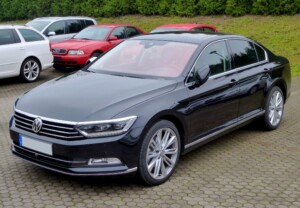
Hence, VW established a plant there to produce the VW Beetle. The Emden plant is more famous, however, for the production of the VW Passat. The first Passat was produced in 1978, and Emden was the Leitwerk (reference plant) for the Passat. It was hence with great sadness of the employees when the production of the Passat was moved from Emden to the Czech Republic. The last Passat was produced in Emden in 2024.
VW also ships many cars through Emden Port. In 2023, there were 1.3 million vehicles shipped, of which 72% were exports and 28% imports. Around 600 vessels dock every year to transport cars. Almost all import and export cars of VW are shipped through Emden.
The All-Electric Emden Plant?
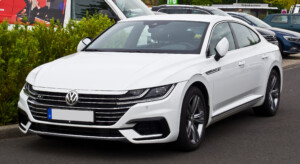
The vision of the VW management is to turn the Emden plant into an all-electric vehicle plant. When I visited, the machinery for the Passat was still there, but completely idle and scheduled for dismantling. The plant still produces the Arteon, which has a combustion or a hybrid engine, but this is sold in very small quantities, and the production of the Arteon will end in October 2024.

The majority of the production are the fully electric ID.4 SUV and the larger ID.7 (also as a tourer version), both part of the MEB platform (Modularer E-Antriebs-Baukasten), their platform for electric vehicles. Over 20 different models from VW, Skoda, Cupra, Audi, and (through a cooperation) also from Ford use this platform.
Some people love electric cars, others hate them. I personally believe that the electric car is the future, albeit there are still some problems to overcome (especially the durability, range, and rechargeability of batteries, as well as the electric infrastructure). As such, I am still driving a hybrid or gasoline car (Toyota, of course!).
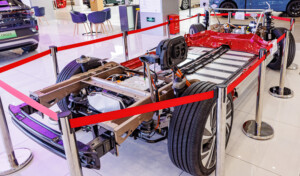
German car makers excel at making combustion engines—highly complex and complicated machines that need lots of experience. On the other hand, everybody can build an electric motor. The expertise for electric cars lies in the battery and the software, both of which are technologies where German car makers are merely average. Hence, the competition can make electric cars of similar quality to Volkswagen… albeit depending on the location much cheaper.
Hence, to stay competitive VW is forced to sell the ID.3 in China as of 2024 for around 16 000 euro… whereas a German customer would have to pay 40 000 euro for pretty much the same car! And they still have only a pitiful e-vehicle market share of only 2.8% in China (source), whereas they are one of the major brands for combustion engine vehicles in China.
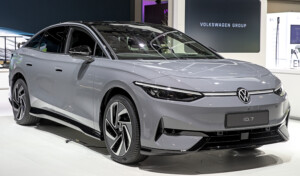
Exports of inexpensive electric vehicles from Chinese brands to the EU will probably squeeze VW even in its home market (unless politics intervenes with protectionist measures). On top of that, German customer are currently rather hesitant buyers of electric vehicles in general.
Overall, there is quite a chance that the electric car demand for Volkswagen will crash. If it crashes, then the all-electric car plant of Volkswagen in Emden will be the front bumper. In fact, the crash is already happening. The plant is reduced to a single shift, at a reduced takt of roughly half capacity, with occasional additional closure days due to a lack of demand. In my estimate, the plant is running at less than 25% capacity (1 shift double takt vs 2 shifts normal takt). Elderly employees are nudged toward an early retirement, with severance payments offered between 17 000 euro and an extremely generous 450 000 euro (source). VW wants to significantly reduce the labor force.
Other car makers do have a bit more flexibility, since most of them opt to build all kinds of power trains (diesel, gasoline, hybrid, and electric) on the same assembly line, which allows a faster switch of production to better performing models. Emden does not have this option.
My Impression of Emden
It is unfortunate that this Damocles’ sword is hanging over the Emden plant, since the plant is actually not bad, and in my view the best Volkswagen brand plant I have seen so far (albeit Porsche Zuffenhausen, which is also part of the VW group, was better, especially the Taycan line).
It is one of the better plants in Germany (albeit still far behind Toyota). The plant was quite clean, much cleaner than other VW or Audi plants, and comparable to Porsche and BWM. Due to the generous offers of early retirement, the average age was quite young, and I was also surprised about how many women worked on the assembly line (15% female workforce according to our guide). Surprisingly, despite the gloomy economic outlook, the workers looked overall happy and cheerful. It looks like VW Emden is a good place to work (assuming they have a job for you).
Press Shop
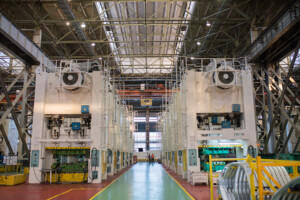
We visited the body shop (Hall 18) as well as the final assembly line (Hall 20). The press shop looked very clean, comparable to Porsche and BMW, and much cleaner than other VW brand plants or Audi plants. Around 1000 robots weld cars together, supervised by a mere 100 employees per shift. The press shop ran at a takt of 69 seconds per car body.
VW is proud of its laser-soldered roofs, albeit to me this looked overly complicated. There were two preceding stations where robots grind and lye-wash the edges of both the car body and the roof to be soldered, before the actual tin laser soldering. Afterwards, another set of grinding robots cleaned up the weld. This was followed by a visual inspection of the soldering lines. Overall, this felt quite complicated and expensive to me.
We also saw a shift change, and—as in many plants—it took some time before the line was running at full capacity again.
Final Assembly
The final assembly in Hall 20 produced the fully electric ID.4, the ID.7, and the ID.7 Tourer (The small quantity combustion engine Arteon was produced elsewhere). This was also a clean and (for German standards) well-organized production line. The line could produce cars at a takt of 60ish seconds, but due to the lack of demand the takt was only 117 seconds per vehicle.
The areas where batteries were stored or assembled had a LOT of sprinklers. A burning battery is quite a risk for the plant. The batteries are heated or cooled to a set temperature before installation, independent of the outside weather.

As always, I also estimated the percentage of value adding time. For the battery installation, this was 48%, for the undercarriage 45%, and for the final assembly it was 47%. While not outstanding, it is decent for German standards, and among the best in the Volkswagen group (only Porsche has sometimes a better efficiency). Still, BMW and Toyota are much better. Team sizes were between 15–20 employees, also much larger than at Toyota with 4–5 people per team leader.
The marriage of the undercarriage with the car body was fully automated (with two people for plugging in cables). The assembly of the wheels was still a lot of manual work. This is supposed to be automated soon, but VW is currently burning money and needs to tighten its belt, hence the automation is on the back burner.
The layout of the lines, however, was a bit odd. There were 13 line segments in parallel, with roads in between (labeled A to O). However, the order of the segments was somewhat odd, and segments with almost completed cars were adjacent to segments with barely the painted car body. In between were door and dashboard assembly lines. Overhead was a system connecting the segments, which was also the buffer. Buffering is good to decouple fluctuations, and a problem in one segment does not turn off the entire plant. However, the total buffer length was about 7km, or over 1000 cars. For one shift with a takt of 117 seconds, this would be over 5 days of buffer overhead. That is a lot!
Overall, a good plant that suffers from the overall weakness of the VW electric vehicles. In my second-to-next post I will look in more detail at the Volkswagen Osnabrück plant, which is also decent, but suffers from a lack of love and especially money for investments from the Volkswagen headquarters. But before that, another anniversary is coming up next week, too. Now, go out, learn about the importance of flexibility so you can adjust your production to what your customer really wants, and organize your industry!
PS: Many thanks to Volkswagen for offering tours through their plants to the public!
Discover more from AllAboutLean.com
Subscribe to get the latest posts sent to your email.
